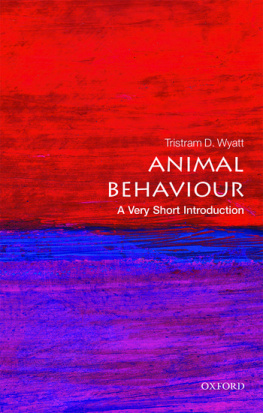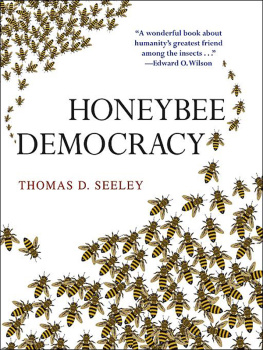Collective Animal Behavior
Collective Animal Behavior
DAVID J. T. SUMPTER

Copyright 2010 by Princeton University Press Published by Princeton University Press, 41 William Street, Princeton, New Jersey 08540
In the United Kingdom: Princeton University Press, 6 Oxford Street, Woodstock, Oxfordshire OX20 1TW
All Rights Reserved
Library of Congress Cataloging-in-Publication Data Sumpter, David J. T., 1973 Collective animal behavior / David J. T. Sumpter.
p. cm.
Includes bibliographical references and index.
ISBN 978-0-691-12963-1 (hardcover : alk. paper) 1. Social behavior in animals. 2. Collective behavior. I. Title. QL775.S86 2010
591.56dc22
2009053055
British Library Cataloging-in-Publication Data is available This book has been composed in Sabon Printed on acid-free paper.
press.princeton.edu
Printed in the United States of America 1 3 5 7 9 10 8 6 4 2
To Lovisa, Henry, and Elise

Contents
Acknowledgments
It is collaboration that allows me to learn and inspires me to work. I enjoy the collective effort involved in the type of research I do. It is probably the importance of social interactions in my own life that led me to the research topic of this book. Is it then a contradiction to this view of the world that I chose to shut myself up and write a book by myself? I dont think so. Although I like working with others, anyone who works with me can confirm that I can be slightly single minded about how I do things. Writing this book has provided an outlet for my own impressions and ideas, which has hopefully allowed me to keep a better balance in my collaborations with others.
There are five biologists, all of whom I met during my final year as a doctoral student, who have greatly contributed to the thinking on which this book is based. Stephen Pratt, Madeleine Beekman, Iain Couzin, Max Reuter, and Dora Biro have in very different ways taught me how to think as a biologist, as well as provided me with endless hours of conversation, entertainment, gossip, intrigue, and downright drunken scandal that has enriched my working life over the last 10 years.
There are two people who have shaped the way I think about mathematics and modeling and I whom would like to thank especially. Having Dave Broomhead as a PhD supervisor taught me a way of approaching the world that has stayed with me ever since and, I hope, is reflected in every mathematical box in this book. Many conversations with Ander Johansson have contributed not only to my understanding of mathematics, but also to its possibilities and limitations in describing science.
Many other people have either commented directly on the text of this book or have, possibly unwittingly, contributed to it through conversation, email exchange, or the odd sentence stolen from a joint paper. These include: ke Brnnstrm, Jerome Buhl, Lisa Collins, Larissa Conradt, Jean-Louis Deneubourg, Audrey Dussutour, Kevin Foster, Nigel Franks, Deborah Gordon, Michael Griesser, Joe Hale, Peter Hedstrm, Kerri Hicks, David Hughes, Duncan Jackson, Neil Johnson, Christian Jost, Alex Kacelnik, Jens Krause, Laurent Lehmann, Esther Miller, Stam Nicolis, Andrea Perna, Sophie Persey, Francis Ratnieks, Steve Simpson, Guy Theraulaz, Ashley Ward, Jamie Wood and Kit Yates. A special thank you to Graeme Ruxton and the two other anonymous reviewers for their highly constructive comments on various drafts of the book.
Thank you to Qi Ma, Etsuko Nonaka, and Daniel Strmbom for their detailed reading of the book and participating in an intensive course based on its contents. A particular thank you to Boris you cant inflict this on the world Granovskiy for both participating in the course and then proofreading the entire book (apart from the acknolwedgements). Thank you to Joachim Munkhammar for creating the webpages for the book and, together with Qi Ma, Kit Yates, and Stam Nicolis, for contributing to some of the simulations in the modeling boxes.
I wrote most of this book during the winter of 2006 and spring of 2007. During this time I worked half-time and the other half of my time I was on parental leave. Thank you, Elise and Henry, for always forgiving my preoccupation with other matters when I should have been fully dedicated to you. Thank you to Lovisa, for her love, support, patience, and inspiration. Thanks also to my mum, dad, and family for their constant support.
Thank you to Sam Elworthy, Alison Kalett, Janie Chan, Stefani Wexler, Sara Lerner, Lor Gehret, and all the other staff at Princeton University Press for all their work in preparing this book for publication.
Lastly, I would like to thank the Royal Society, whose flexible and long-term funding gave me the time and confidence to write the first half of this book, and the mathematics department at Uppsala University, for providing me with such a wonderful working environment while I was getting through the second half.
Chapter 1
Introduction
Some scientists invest an entire career in the study of organisms of a single species, others in understanding particular types of cells or in determining the role of a certain gene. The elements of each level of biological organization can take more than a lifetime to understand. How then can we put all this information together? Understand how genes interact to drive the cell, how cells interact to form organisms, and how organisms interact to form groups and societies? These questions are fundamental to the scientific endeavor: how do we use our understanding of one level of organization to inform us about the level above?
Linking different levels of organization involves the study of collective phenomena: phenomena in which repeated interactions among many individuals produce patterns on a scale larger than themselves. Collective phenomena are within us and all around us: the clustering of cells to build our bodies, the firing of neurons in our brains, flocks of birds twisting above our heads, and the pulsating mass of bodies surrounding us on a Saturday night dance floor. Understanding these phenomena is an important part of the fields of developmental biology, neuroscience, behavioral ecology, and sociology, to name just a few. Even researchers studying the most intricate details of the components of a particular system are acutely aware of the need to understand how these components fit together to create a whole system.
The study of collective phenomena is founded on the idea that a set of techniques can be applied to understand systems at many different physical scales. This idea originated from mathematics, theoretical physics, and chemistry. Books by Wiener (1948), Ashby (1947), von Bertalanffy (1968) and Nicolis & Prigogine (1977) all aimed at providing a framework for the study of collective phenomena. Von Bertalanffy argued for the existence of general growth laws of social entities as diverse as manufacturing companies, urbanization, and Napoleons empire. Wiener argued that homeostasis, a stable functioning of natural systems, could be achieved through simple feedback loops. Nicolis and Prigogine aimed to pin down a rigorous theory of non-linear thermodynamics, explaining similarities between systems at very different scales. For example, could the flow of traffic be described by the mathematics of fluid flow? And if this were the case could we make general statements about the flow of any type of matter, be it swarms of locusts, crowds leaving football grounds, or water running down the drain?
Next page









